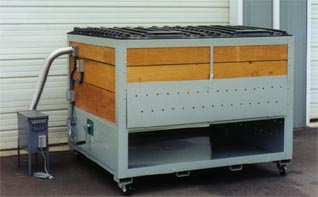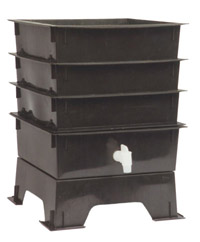

| Vermiculture and Vermicomposting |
||
| Components | ||
Worms Different species of worms have different life histories, occupy different ecological niches, and have been classified, on the basis of their feeding and burrowing strategies, into three ecological categories: Epigeic: These are the worms used in vermicomposting. Epigeic worms are litter dwellers and litter transformers that live in the organic soil horizon, in or near the surface litter, and feed primarily on coarse particulate organic matter. They ingest large amounts of undecomposed litter and excrete holorganic fecal pellets. These species are small in body size and uniformly pigmented with high metabolic and reproductive rates, which represent adaptions to the highly variable environmental conditions at the soil surface. Types of epigeic worms suitable for vermicomposting include: Eisenia fetida: “red wigglers” - capable of processing large amounts of organic material in their natural habitat of manure, compost piles or decaying leaves. Reproducing quickly, they tolerate a wide range of temperatures, acidity, and moisture conditions – in addition to handling the stress related to handling and shipping well. Also suitable is a close relative, Eisenia andrei. Lumbricus rubellus: this worm has been found in both compost and in soil very rich in organic matter, thus in some cases it can provide additional benefits by burrowing deeper into soil, mixing worm castings and organic material with existing soil. Eudrilus eugeniae and Perionyx excavatus: tropical species suitable for warmer climates.
The two remaining types, unsuitable for vermicomposting: Anecic and Endogeic: these are burrowers, which live in soil and consume a mixture of soil and organic matter, and excrete organomineral feces. Soil dwelling worms prefer cooler temperatures, thus they cannot tolerate the heat created by the process of breaking down organic matter on the soil surface. They tend to be solitary, and prefer to be undisturbed. Soil dwelling worms drag organic matter into their burrows, and mix organic matter deeper into the soil, but do not consume the volume of organic matter that compost dwelling worms are capable of. Vermicomposting Systems Harvesting worm castings without destroying the current worm population is the tricky part of vermicomposting. High tech systems, costing thousands of dollars, are one option, and they provide ann engineered, mechanical method of harvest. Low tech systems require more manual labor to harvest vermicompost. Large-scale Systems
Worm Wigwam sold by Yelm Earthworm and Castings (Yelm, WA). This is the new, large-scale version of the premier continuous-flow worm bin for use by cafeterias, restaurants, and other institutions. With approximately 30 square feet of surface area and insulated walls, it is designed to handle at least 75 pounds of food and bedding every day; and it is completely covered and verminproof. The mechanical harvesting system makes collecting worm castings very efficient. Cost: $6,200. Small-scale Home System
Sold by many vendors, this home-system supports up to 15 lbs. of worms and can handle about 7 lbs. of kitchen scraps daily. The total worm composting volume of 1.5 cubic feet includes 3 stacking (16" x 16") trays to contain earthworms and composting materials. Cost: $90. Low Tech-Scalable
Windrow vermicomposting is the simplest, yet most labor intensive method. Care must be taken to not damage living worms while harvesting worm castings. This method is used on a large scale in countries such as India, Philippines, and Cuba. Cost: minimal capital costs. |
||
|
||

